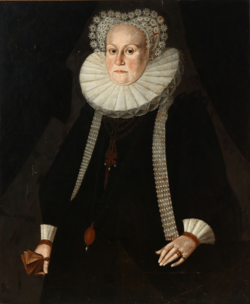Sophie of Mecklenburg-Güstrow facts for kids
Quick facts for kids Sophie of Mecklenburg-Güstrow |
|
|---|---|
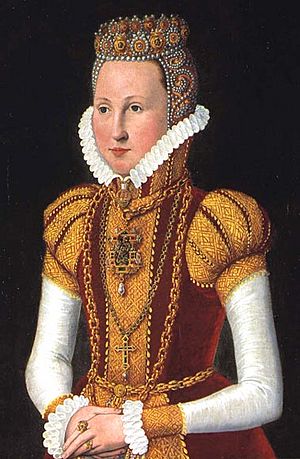
|
|
| Queen consort of Denmark and Norway | |
| Tenure | 20 July 1572 - 4 April 1588 |
| Born | 4 September 1557 Wismar |
| Died | 14 October 1631 (aged 74) Nykøbing Castle, Falster |
| Burial | Roskilde Cathedral |
| Spouse | Frederick II of Denmark |
| Issue | Elizabeth, Duchess of Brunswick Anne, Queen of England and Scotland Christian IV of Denmark Ulrich II, Prince-Bishop of Schwerin Augusta, Duchess Holstein-Gottorp Hedwig, Electress of Saxony John, Prince of Schleswig-Holstein |
| House | Mecklenburg-Schwerin |
| Father | Ulrich III of Mecklenburg-Güstrow |
| Mother | Elizabeth of Denmark |
| Religion | Lutheranism |
Sophie of Mecklenburg-Güstrow (born September 4, 1557 – died October 14, 1631) was a powerful Queen of Denmark and Norway. She became queen by marrying Frederick II of Denmark. Sophie was the mother of King Christian IV of Denmark and Anne of Denmark, who later became Queen of England and Scotland. From 1590 to 1594, she also acted as a ruler for the regions of Schleswig-Holstein.
Sophie married her cousin, Frederick II of Denmark, in 1572. Their marriage was known to be very happy. During their marriage, Sophie did not have much political power. However, she managed her own royal household. She also supported many artists and thinkers. Sophie was very interested in astrology (the study of how stars affect people), chemistry, and alchemy (an old form of chemistry). She even visited the famous astronomer Tycho Brahe in 1586. People later described her as a very smart woman. She was especially known for supporting scientists. She became a widow at the age of 31.
After her husband died, Sophie took control of her large estates. She managed them so well that she became incredibly rich. She was the wealthiest woman in Northern Europe. She was also the second richest person in all of Europe. Sophie used her huge wealth to help her son, King Christian IV. This support also helped the entire Danish-Norwegian country. She ran a large business lending money. She lent money to her son Christian IV and to the Danish government. She also lent money to her son-in-law, King James VI and I of Scotland and England. When she died in 1631, she was called the "richest Queen in Christendom."
Contents
Early Life of Queen Sophie
Sophie was born in Wismar, a city in Germany. Her father was Duke Ulrich III of Mecklenburg-Güstrow. Her mother was Princess Elizabeth of Denmark, Duchess of Mecklenburg. Elizabeth was the daughter of Frederick I of Denmark, who was King of Denmark. Sophie loved learning, just like her father. She became known as one of the most educated queens of her time.
Becoming Queen of Denmark
When Sophie was just fourteen years old, she married Frederick II of Denmark. The wedding took place in Copenhagen on July 20, 1572. Frederick was thirty-eight years old. She was crowned Queen the very next day. Sophie and Frederick were half-cousins because they shared the same grandfather, King Frederick I.
They first met at Nykøbing Castle. The king was supposed to meet another princess, Margaret of Pomerania. But Sophie's parents brought her along too. King Frederick liked Sophie very much. He decided to marry her instead. They got married six months later. Before this, King Frederick had been in love with a noblewoman named Anne Corfitzdatter Hardenberg. But he could not marry her because she was not a princess. The Danish government also did not approve.
Even with the age difference, Sophie and Frederick had a happy marriage. Queen Sophie was a loving mother. She took care of her children herself when they were sick. In 1575, when Frederick was ill, she nursed him. She wrote many worried letters to her father about his health. King Frederick also loved Sophie very much. He wrote about her fondly in his personal diary. Their marriage was described as very peaceful.
Most of their children were sent to live with Sophie's parents in Mecklenburg for their first few years. This was a common belief at the time. People thought parents might spoil their children too much if they stayed at home. Sophie was very interested in science. She visited the famous astronomer Tycho Brahe. She also loved old folk songs and stories.
Sophie as a Matchmaker
After Frederick's death, Sophie became very important as a matchmaker. She arranged marriages for her children. Her daughter, Anne of Denmark, married James VI of Scotland in 1589. Anne became Queen of Scotland and later England. Sophie arranged this marriage even though the government council did not want it. When King James VI visited Denmark, Sophie gave him a gift of 10,000 Danish coins.
She also helped arrange the marriage of her daughter, Princess Elizabeth, to Henry Julius, Duke of Brunswick-Lüneburg. Sophie managed to raise 150,000 coins for these two weddings and other costs. She spent 50,000 coins herself on jewelry.
In 1596, she arranged for her daughter Princess Augusta to marry John Adolf, Duke of Holstein-Gottorp. This marriage helped Denmark connect better with other German states. Finally, in 1602, she arranged the marriage of Hedwig to Christian II, Elector of Saxony. She also helped find suitable partners for her younger sons. Sophie was the main person who arranged the marriage for her son Christian, who would become king. He married Princess Anne Catherine of Brandenburg, whom Sophie called a "pure pearl."
Sophie's Life as a Widow
Queen Sophie had no political power while her husband was alive. When her son Christian IV became king in 1588, he was still young. Sophie was not given a place on the council that ruled Denmark for him. However, from 1590, she did rule the regions of Schleswig-Holstein for her son.
She planned a grand funeral for her husband. She also arranged for her daughters' wedding money and her own income. She did all this on her own, against the wishes of the council. She had disagreements with the Danish government. They declared Christian old enough to rule in 1593. Sophie wanted her younger sons to share the duchies, which caused more conflict. Sophie finally gave up her ruling position in 1594. After this, she focused on making sure she had enough money and power to stay important in Denmark.
A Rich Landowner and Businesswoman
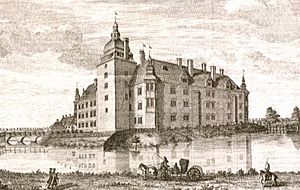
As a queen who had lost her husband, Sophie was given a special income and castles. These large estates included Lolland, Denmark's fourth-largest island, and the nearby island of Falster. Her main castle, Nykøbing Castle, was on Falster. She also received other castles and lands. She managed to get 30,000 coins from her late husband's money. She also received 8,000 coins each year from taxes on ships. Over time, her lands on Lolland and Falster grew even larger. Many properties were added to her estates.
During her long widowhood, Sophie spent most of her time managing her lands. She was like an independent ruler there. She protected the people living on her lands. She also became very involved in large-scale trade and lending money. She was interested in new ways of farming. She changed her land to grow crops on a large scale. She sold grain and cattle to northern Germany. She had a large network of contacts in different regions. She built mills and was especially interested in raising cattle. This was a very important way to earn money back then. Queen Sophie managed her estates so well that her son, the King, often borrowed money from her for his wars.
She helped pay for her son Christian IV's military campaign against Sweden in 1611, called the Kalmar War. She also helped him join the Thirty Years' War in 1615. In 1605, she lent her son 140,000 Danish coins. With this money, Christian launched several trips to Greenland. In 1614, Christian IV borrowed another 210,000 coins from his mother. In 1621, the Danish government borrowed 100,000 and then 280,000 coins from the Queen. This money helped cover the country's debts. Most of the money Queen Sophie lent to her son was never paid back.
In 1620-1621, Queen Sophie was the main person who lent 300,000 coins from Denmark to England. Her son-in-law, King James VI and I, ruled England. The loan had a very good interest rate of 6%. Besides her huge amount of cash, she also owned many properties in northern Germany. These properties were given to her as security by princes who owed her money. The Queen visited these estates during her many travels.
Sophie's Political Influence as a Widow
Because she was so wealthy, Queen Sophie had a lot of influence. She affected both Danish politics and international affairs in Northern Europe. This was during the reign of her son, Christian IV (who ruled from 1596 to 1648). From her husband's death in 1588 until her own death 43 years later, she was active in Danish political life. The Queen always knew what was happening in Europe. She kept up with events through many letters with Protestant princes and her relatives in Mecklenburg-Güstrow.
Within Denmark, Sophie helped the country by constantly lending money. Her letters also show that she discussed taxes with her son.
The Queen also had international political power. This was because she lent money to princes in northern Germany. During the Thirty Years' War, she lent money to several German Protestant princes. Her grandson, Frederick Ulrich, Duke of Brunswick-Lüneburg, owed her 300,000 Danish coins. Her son-in-law, John Adolf, Duke of Holstein-Gottorp, also owed her 300,000 coins. She even had financial dealings with the leader of the Catholic forces, Johann Tserclaes, Count of Tilly. She wanted to work with him to get her money back.
Later Life and Great Fortune
Sophie often visited Mecklenburg. In 1602, she went to her daughter's wedding in Dresden. In 1603, she had a disagreement about an inheritance with her uncle. This problem was not solved before he died in 1610. In 1608, she helped to reduce the punishment for a woman named Rigborg Brockenhuus. In 1628, she was one of the important people who stopped her son from accusing his grandson's girlfriend, Anne Lykke, of witchcraft.
When Sophie died in 1631 at Nykøbing Falster, she was 74 years old. She was the richest woman in Europe. She left a huge amount of money, about 5.5 million Danish coins. This was about 13 times more than the Danish government's yearly budget at that time.
Burial and Inheritance Dispute
When she died, Sophie had three living children: Christian, Hedwig, and Augusta. Four of her children had died before her. All three living children attended her funeral, which was very grand. Her body was taken from Nykøbing to Copenhagen. A special funeral service was held in the Church of Our Lady on November 13, 1631. The next day, her body was moved to Roskilde Cathedral. She was buried in the chapel next to her husband.
Queen Sophie did not leave a formal will. But in a letter to her son King Christian, she said her three living children should receive a special portion. The rest of her wealth was to be divided according to law, except for a few gifts she wanted to give.
After Sophie's death, a disagreement quickly started over her inheritance. Her grandson, Charles I, immediately sent an ambassador to Denmark. He wanted to offer his condolences and claim part of the inheritance. Sophie's granddaughter, Elizabeth Stuart, Queen of Bohemia, also wanted a share. She had not inherited anything from her mother, Anne of Denmark. So, she argued that she should get some of her brother's inheritance from their grandmother. Charles first agreed, but when he found out how much money there was, he changed his mind. However, Christian IV quickly took most of the inheritance. He claimed that what he took was only to pay back some of England's debt to him.
Children of Sophie and Frederick
Sophie and Frederick had seven children:
| Name | Portrait | Birth | Death | Notes |
|---|---|---|---|---|
| Elizabeth of Denmark | 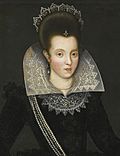 |
August 25, 1573 | June 19, 1625 | She married Henry Julius, Duke of Brunswick-Lüneburg in 1590. They had 10 children. |
| Anne of Denmark | 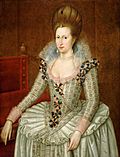 |
December 12, 1574 | March 2, 1619 | She married King James VI of Scotland (who later became King James I of England) in 1589. They had 7 children. |
| Christian IV, King of Denmark and Norway | 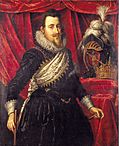 |
April 12, 1577 | February 28, 1648 | He first married Anne Catherine of Brandenburg in 1597. They had 7 children.
He later married Kirsten Munk. They had 12 children. Christian also had at least 5 other children outside of marriage. |
| Ulrik of Denmark | 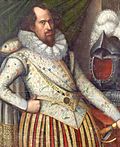 |
December 30, 1578 | March 27, 1624 | He became the last Bishop of Schleswig (1602–1624).
He also became Ulrich II, the Administrator of the Bishopric of Schwerin (1603–1624). He married Lady Catherine Hahn-Hinrichshagen. |
| Augusta of Denmark | 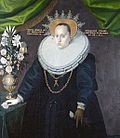 |
April 8, 1580 | February 5, 1639 | She married John Adolf, Duke of Holstein-Gottorp in 1596. They had 8 children. |
| Hedwig of Denmark |  |
August 5, 1581 | November 26, 1641 | She married Christian II, Elector of Saxony in 1602. They had no children. |
| John of Denmark, Prince of Schleswig-Holstein |  |
July 9, 1583 | October 28, 1602 | He was supposed to marry Tsarevna Ksenia, daughter of Boris Godunov, the Tsar of Russia. But he died before the wedding. |
See also
 In Spanish: Sofía de Mecklemburgo-Güstrow para niños
In Spanish: Sofía de Mecklemburgo-Güstrow para niños


